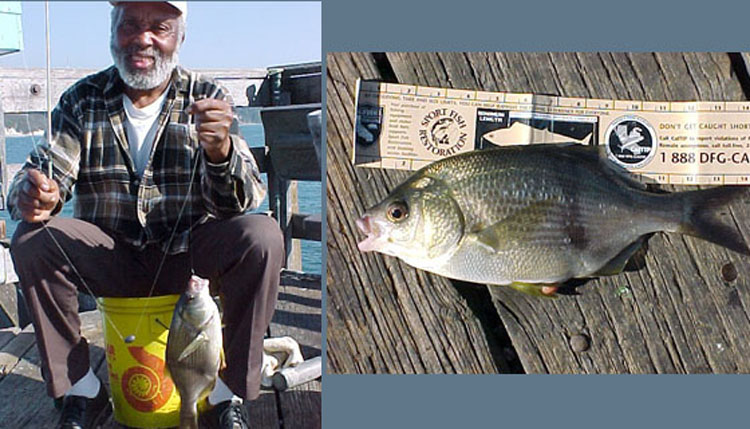 Pileperch from Monterey Wharf $2
Pileperch from Monterey Wharf $2
Species: Damalichthys vacca (Girard, 1855); from the Greek root words racos (ragged) and cheilos (lips) and the Latin word vacca (like a cow). Family Embiotocidae, subfamily Embiotocinae.
Alternate Names: Splittail perch, forktail perch, dusky perch, white perch, silver perch, piler perch, and porgy. In Mexico called mojarra muellera or perca.
Identification: Pile perch are distinguished by the black spot on the cheek, the very deeply forked tail, and the very tall, first soft rays on the dorsal fin that are about twice the height of the last spines. Color is dark brassy-brown, fading to silver on sides and belly; often has yellow pelvic fins. Pile perch have one dusky, vertical bar across the side at about the high point of the soft dorsal. The posterior position of the bar and the deeply forked caudal fin (tail) distinguish it from sargo.
 Pileperch (and Hashem) from the Cabrillo Pier in San Pedro
Pileperch (and Hashem) from the Cabrillo Pier in San Pedro
Size: To 17 1/4 inches; most caught from piers are 10-14 inches. The California record fish weighed 1 lb 15 oz and was taken at Long Beach in 2007.
Range: Isla Guadalupe (and possibly Bahia Playa Maria), central Baja California to southern British Columbia. Unverified report to Port Wrangell, Alaska.
 Pileperch from the Elephant Rock Pier
Pileperch from the Elephant Rock Pier
Habitat: Shallow-water, rocky-areas, and around piers and docks, both oceanfront and in bays. Typically they are a bottom dwelling species, called “benthic grazing carnivores” by some. Others classify them as “commuter” fish that move between different habitats in search of prey. All agree they are primarily day feeders seeking out large, hard-shelled invertebrates that they are able to crush with their well developed, fused pharyngeal tooth plates. Since other perch do not share this ability, some scientists feel pile perch should be placed in a separate genus —Danalichthys. Foods include crabs, brittle stars, sand dollars, barnacles, bean clams, (whole) mussels, limpets, dove shells, California cones, Norris top shells, and chitons.
 Pileperch (and Redfish aka Robert Gardner) from the Cabrillo Mole in Avalon
Pileperch (and Redfish aka Robert Gardner) from the Cabrillo Mole in Avalon
Piers: Pile perch are taken at virtually every pier in California but the largest numbers are taken at Bay Area piers. Best bets: Santa Monica Pier, Stearns Wharf, Goleta Pier, North T-Pier and South T-Pier in Morro Bay, San Francisco Municipal Pier, Berkeley Pier, Point Pinole Pier and McNear Beach Pier.
Shoreline: A favored species for shore anglers fishing in bays throughout the state.
Boats: An inshore species sometimes taken by boaters fishing in bays, especially San Francisco Bay.
 Pileperch from the Goleta Pier
Pileperch from the Goleta Pier
Bait and Tackle: Pile perch can be exasperatingly difficult to catch. The large perch will often be seen placidly swimming in clear view around the mussel-covered pilings while refusing to partake of the offerings of the gods up above—anglers whose mojo is evidently on empty. Damalichthys vacca do seem a little easier to catch when in their dense schools are a’spawning. Perhaps their pea-sized brains are distracted and normal caution takes a back seat to other thoughts? The most common setup is to use a high/low leader with number 6 or 4 hooks, light line, and a light sinker. Best bait in southern California seems to be fresh mussels, rock crabs or bloodworms. In the Bay Area, grass shrimp, rock crabs, pile worms or fresh mussels are best. In Humboldt Bay, frozen tube worms or crab backs are most commonly used. Usually pile perch are nestled up next to the pilings; fish accordingly. Check out the shoreline by the pier at low tide and grab some local live bait—small crabs, mussels, worms, snails or clams; these will usually make the best bait.
Food Value: Although large sized and yielding some usable meat, the flesh is only fair in taste.
 Pileperch from the North T-Pier in Morro Bay
Pileperch from the North T-Pier in Morro Bay
Comments: Many years ago, at Newport Pier, I watched an old-timer show one way to catch the perch. Pile perch were doing their typical trick d’tease: big fish showing a leg but refusing to bite. The old-timer tried out a trick of his own. He took out a mass of recently pried loose mussels, at least a dozen in the clump, and in and around this mussel-mass he wound a leader that had several number 8 hooks attached. Then he attached the leader to a handline and carefully dropped it down next to the pilings. This new mini-piling soon attracted the fish and he was able to catch several of the large pile perch. Sporting? I’m not sure, but it sure was effective. Since then, I’ve seen variations of this technique at both the Santa Monica Pier and at Stearns Wharf in Santa Barbara and heard stories of its use at the Goleta Pier.
 Pileperch (and CayucosJack) from the North T-Pier in Morro Bay
Pileperch (and CayucosJack) from the North T-Pier in Morro Bay
Many thanks to Robert O’H for the help with the pictures.















What type of rods would you use? Ultralight or Light spinning? And would 8lb test line be ok?
Given the fact that you are often fishing right by the mussels on the piling I would stick to light but not ultralight line and tackle. Pileperch are often good size and once they bite you need to get them away from those sharp-edged mussels.